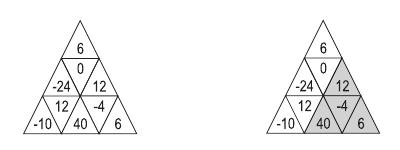当前你的浏览器版本过低,网站已在兼容模式下运行,兼容模式仅提供最小功能支持,网站样式可能显示不正常。
请尽快升级浏览器以体验网站在线编辑、在线运行等功能。
2921:Adding up Triangles
题目描述
Take a look at the triangle on the left of the figure below. It is made of 9 (unit) triangles arranged in three rows (N = 3 ). Needless to say, a unit triangle is a triangle with N = 1 .

If you study the figure for few seconds, you'll realize that you can find 13 different triangles (which we'll call sub-triangles.) Of these 13 sub-triangles we have: Nine unit triangle; three with N = 2 , and one with N = 3 . The following table lists the number of sub-triangles in arrangements with N < 5 .

Let's define the value of a unit triangle to be the integer value written in that triangle. In general, the value of a triangle is the sum of values in all its unit triangles. The triangle on the right is the same as the other one but with the sub-triangle having the largest value being highlighted. Write a program to determine the sub-triangle with the largest value.

If you study the figure for few seconds, you'll realize that you can find 13 different triangles (which we'll call sub-triangles.) Of these 13 sub-triangles we have: Nine unit triangle; three with N = 2 , and one with N = 3 . The following table lists the number of sub-triangles in arrangements with N < 5 .

Let's define the value of a unit triangle to be the integer value written in that triangle. In general, the value of a triangle is the sum of values in all its unit triangles. The triangle on the right is the same as the other one but with the sub-triangle having the largest value being highlighted. Write a program to determine the sub-triangle with the largest value.
输入解释
Your program will be tested on one or more test cases. Each test case is specified in a single line made of integers (separated by spaces.) The first integer is the number of rows in the test case, and the remaining integers are the values of the unit triangles specified in a top-down, left-to-right order. (the first test case in the example below is the same as the one in the figure.) The last line of the input file contains the number 0 (which is not part of the test cases.)
The maximum number of rows is 400. The absolute value of a unit triangle is less than 1000.
The maximum number of rows is 400. The absolute value of a unit triangle is less than 1000.
输出解释
For each test case, print the result using the following format:
k . V
where k is the test case number (starting at 1,) is a single space, and V is the maximum value of a sub-triangle in that test case.
k . V
where k is the test case number (starting at 1,) is a single space, and V is the maximum value of a sub-triangle in that test case.
输入样例
3 6 -24 0 12 -10 12 40 -4 6 4 1 1 -1 1 1 -1 1 -1 1 1 -1 1 -1 1 -1 1 0
输出样例
1. 54 2. 4
来自杭电HDUOJ的附加信息
| Recommend | lcy |
最后修改于 2020-10-25T22:58:13+00:00 由爬虫自动更新
共提交 0 次
通过率 --%
| 时间上限 | 内存上限 |
| 8000/4000MS(Java/Others) | 32768/32768K(Java/Others) |
登陆或注册以提交代码